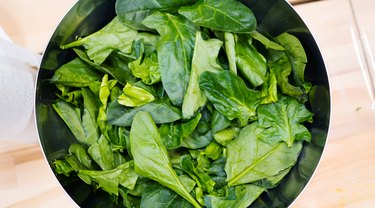
It's a bit of advice you hear over and over again — eat your greens. Many people recognize that it's important to eat lots of green vegetables, and with steamed spinach being as versatile as it is in many meals and snacks, there's no excuse for not getting plenty of this powerhouse food.
Health Benefits of Spinach
Video of the Day
What is it about spinach that makes it such an acclaimed health food? Well, as the USDA lists, a cup of raw spinach has only 7 calories, but it is full of vitamins and minerals. That 1-cup serving has about:
Video of the Day
- 5 percent of your daily needed iron
- 4 percent of your daily needed potassium
- 6 percent of your daily needed magnesium
- 16 percent of your daily needed vitamin A
- 9 percent of your daily needed vitamin C
- 4 percent of your daily needed vitamin E
- 121 percent of your daily needed vitamin K
As a July 2015 study published in Clinical Nutrition Research points out, the dietary nitrite that's found in vegetables like spinach is great for cardiovascular health, specifically because it decreases arterial stiffness and central blood pressure.
And even though you can enjoy spinach raw as a base for some delicious, nutrient-dense salads, it makes a great addition to other dishes when it's been cooked. Steaming it will get the leaves wilted for use in some of these dishes without adding too much fat from cooking methods like sautéing.
How to Make Steamed Spinach
To make steamed spinach, the Purdue Extension FoodLink recommends that you start by letting the raw spinach leaves soak in lukewarm water for several minutes to remove the dirt. Afterward, drain them and rinse them under cold water. You can then steam the spinach on the stovetop or cook the spinach in the microwave.
To make steamed spinach on the stovetop, you should:
- Fill a saucepan with 2 inches of water and heat on high until it comes to a rolling boil.
- Set the steamer basket inside the saucepan and add the spinach to the steamer basket.
- Lower the temperature and reduce the water from a boil to a simmer. Place the cover on the saucepan and allow the spinach to steam for approximately two minutes.
- If the spinach is not fully wilted, let it steam for another minute.
In some cases, it's more convenient to cook spinach in the microwave. If you choose to go this route, here's what you should do:
- After washing your spinach leaves, put them in a microwave-safe dish.
- Add about 2 tablespoons of water and cover the dish with a towel.
- Cook the spinach in the microwave at one-minute intervals until the leaves are wilted.
Read more: Disadvantages With Cooking in the Microwave
When you have steamed the spinach on the stovetop or cooked the spinach in the microwave, it's now ready for a variety of uses. You can either add it to a recipe immediately, or you can store it for future use. Steamed spinach will keep in the fridge for four to five days (store it in a plastic container with a damp paper towel to absorb moisture) or in the freezer for up to five months.
Adding Cooked Spinach to Recipes
It's easy to find cooked spinach recipes that will please even the pickiest eaters. The Produce for Better Health Foundation recommends stuffing your steamed spinach inside a sliced chicken breast with low-fat cheese and baking it. You can also use steamed spinach in a smoothie or to make spinach dip.
If you want to go for one of those two options, refer to the cooked spinach recipes on LIVESTRONG.com, such as the Hidden Spinach Smoothie, the Creamy Spinach Dip Snack or the Spinach-Artichoke Dip.
You can also add spinach to a sauce for pasta, meat, poultry or seafood dishes. The USDA has a recipe for pan-fried cod fillets with a tomato and spinach sauce. Even though the recipe calls for frozen spinach, you can easily use your freshly cooked spinach in this recipe. All you have to do is add the steamed spinach to the simmering fish and tomato sauce in the skillet.
Read more: 10 Sneaky Ways to Eat More Vegetables
Or be creative — the next time you make macaroni and cheese, stew or an omelet, increase the nutritional factor by slipping in a little bit of steamed spinach.
- USDA: “Spinach”
- Purdue Extension FoodLink: “Spinach”
- Produce for a Better Health Foundation: “Top 10 Ways to Enjoy Spinach”
- USDA: “Fish with Spinach”
- Clinical Nutrition Research: “Effect of Spinach, a High Dietary Nitrate Source, on Arterial Stiffness and Related Hemodynamic Measures: A Randomized, Controlled Trial in Healthy Adults”